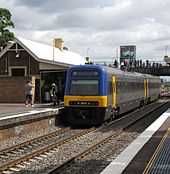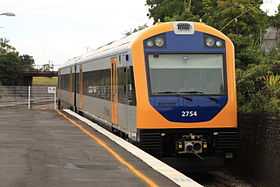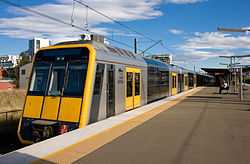NSW TrainLink
| NSW TrainLink | |
|---|---|
 | |
 V set at Sydney Central in August 2013 | |
| Background | |
| Locale |
Regional New South Wales Intercity services Interstate Services |
| Transit type | Intercity and regional rail |
| Website | www.nswtrainlink.info |
| Operation | |
| Began operation | 1 July 2013 |
| Operator(s) | Transport for New South Wales |
| Technical | |
| Track gauge | 1,435 mm (4 ft 8 1⁄2 in) standard gauge |
| Electrification | 1,500V (DC) overhead line |
NSW TrainLink is a brand for all New South Wales passenger rail services and some coach services outside of metropolitan Sydney. NSW TrainLink is a subsidiary of Transport for New South Wales.[1][2] Train services are operated by the state government owned NSW Trains, while coach services are provided by private operators.
History
In May 2012 the Minister for Transport announced a restructure of RailCorp.[3][4][5][6]
The NSW TrainLink brand was introduced on 1 July 2013 to coincide with NSW Trains taking over all of CountryLink's services and CityRail's non-suburban services.
NSW Trains also took responsibility from RailCorp for granting access to and maintaining the Main Northern line from Berowra to Newcastle, the Main Western line from Emu Plains to Bowenfels and the South Coast line from Waterfall to Bomaderry.
RailCorp's remaining function is primarily as custodian of railway real estate, infrastructure and trains.[7]
Quiet carriages
Quiet carriages are designated carriages where noise made by passengers are requested to be kept to a minimum. Passengers are asked to place mobile phones on silent, move carriages in order to have a conversation with another passenger and use headphones when listening to music.[8]
Quiet carriages are on Intercity services are located in four carriages on 8 car sets, two carriages on 4 car sets and one carriage on two car sets.[9]
Quiet carriages were first introduced on the Central Coast & Newcastle Line in early 2012 as a three month trial. On 1 September 2012 quiet carriages were permanently introduced and expanded to all intercity services operating on the Blue Mountains and South Coast lines.[8]
As of 2013, Quiet Carriages now operate on NSW Trainlink network:
- South Coast line: Central to Port Kembla or Kiama and Kiama to Nowra
- Central Coast & Newcastle line: Central to Newcastle
- Blue Mountains Line: Central to Lithgow or Bathurst
- Southern Highlands line: Campbelltown to Moss Vale or Goulburn
- Hunter line: Newcastle to Scone or Dungog
Network
The NSW TrainLink network is divided into two tiers. Intercity lines form part of the Greater Sydney public transport network. Ticketing uses the MyZone and Opal systems and seats are available on a first-come, first-served basis. Regional lines use a separate, reserved seat ticketing system.
Intercity lines

The intercity lines stretch over 200 kilometres from Sydney, as far north as Dungog, as far north-west as Scone, as far west as Bathurst, as far south-west as Goulburn and as far south as Bomaderry.
Electric lines extend from Sydney north to Newcastle, west to Lithgow and south to Port Kembla and Kiama. Most electric trains terminate at Central, the hub of the NSW TrainLink, but local services also run in the Newcastle and Wollongong areas.
Diesel trains serve the more remote or less populated sections of the intercity network. Hunter line services operate from the terminus station at Newcastle to Telarah with some extending to Dungog and Scone. Southern Highlands trains connect Moss Vale to the southern Sydney suburb of Campbelltown, where a change to a connecting Sydney Trains service is generally required to reach the centre of Sydney - though one off-peak service operates directly to Central. A few services continue south form Moss Vale to Goulburn. Diesel services also operate on the South Coast Line between Bomaderry and Kiama, where connecting electric services operate to Sydney.
Train services
| Line colour and name | Between | Electric services | |
|---|---|---|---|
| Blue Mountains line | Central and Lithgow / Bathurst a b | To Lithgow | |
| Central Coast & Newcastle line | Central and Newcastle | Yes | |
| South Coast line | Central c and Bomaderry or Port Kembla | To Kiama and Port Kembla | |
| Southern Highlands line | Central or Campbelltown d and Moss Vale, with less frequent services to Goulburn | No | |
| Hunter line | Newcastle and Telarah, with less frequent services to Dungog or Scone | No | |
- ^a Some peak services on the Blue Mountains line run to/from Hornsby
- ^b Some peak services on the Blue Mountains line run to/from Bathurst
- ^c Some peak services and most weekend services on the South Coast line run to/from Bondi Junction
- ^d Some peak services on the Southern Highlands line to/from Central. At other times, a change of train is required at Campbelltown or Macarthur
Bus & coach services
NSW TrainLink operates several bus routes along corridors where the railway line has been closed to passengers or as a supplement to rail services. These bus services are operated by private sector bus companies contracted by NSW TrainLink.
| Line colour and name | Between | |
|---|---|---|
| South Coast line | Wollongong to Moss Vale/Bundanoon via Robertson (r) | |
| Southern Highlands line | Moss Vale to Goulburn via Marulan | |
| Southern Highlands line | Picton to Bowral via Thirlmere on weekdays only | |
- ^(r) Seat reservations required
Regional lines

NSW TrainLink operates passenger services throughout New South Wales and interstate to Brisbane, Canberra and Melbourne. All rail services feature diesel rolling stock.
North Coast
The North Coast region covers the North Coast, Northern Rivers and South-East Queensland regions. Accordingly, the Government of Queensland makes a contribution to the provision of these services. North Coast region services appear on the network map in red. Services run along the Main North and North Coast lines from Sydney Central station to Roma Street station in Brisbane.[10]
Principal stations served by XPT trains are:
Cities and towns served by NSW TrainLink coaches connecting off North Coast services include: Tea Gardens, Forster, Port Macquarie, Yamba, Moree, Lismore, Alstonville, Lismore, Ballina, Byron Bay, Murwillumbah, Tweed Heads and Surfers Paradise.
North Western
The North Western region covers the state's Hunter, Northern Tablelands and North West regions. North Western region services appear on the network map in orange. Services run along the Main North line from Sydney Central station to Werris Creek where the service divides for Armidale and Moree.[11]
Principal stations served by Xplorer trains are:
Cities and towns served by NSW TrainLink coaches connecting off North Western services include: Wee Waa, Inverell, Grafton, Glen Innes and Tenterfield.
Western
The Western region covers the Central Tablelands and Western regions. Western region services appear on the network map in yellow. Services run along the Main Western line from Sydney Central station to Dubbo and the Broken Hill line to Broken Hill.[12]
Principal stations served by XPT trains are:
Principal stations served by Xplorer trains are:
Cities and towns served by NSW TrainLink coaches connecting off Southern services include: Oberon, Mudgee, Baradine, Cowra, Grenfell, Forbes, Parkes, Condobolin, Lightning Ridge Brewarrina, Bourke, Warren and Broken Hill.
Southern
The Southern region covers the state's Illawarra, South Coast, Snowy Mountains, South West Slopes, Southern Tablelands, Riverina and Sunraysia regions plus the Australian Capital Territory and parts of Victoria. Accordingly the Government of Victoria (though not the ACT Government) makes a contribution to the provision of these services. Southern region services appear on the network map in green. Services run along the Main South from Sydney Central station to Albury before continuing on the North East line to Southern Cross Station in Melbourne, with the line to Canberra branching off south of Goulburn and the line to Griffith at Junee.[13]
Principal stations served by XPT trains are:
Principal stations served by Xplorer trains are:
Cities and towns served by NSW TrainLink coaches connecting off Southern services include: Wollongong, Bombala, Eden, Tumbarumba, Bathurst, Dubbo, Condobolin, Griffith, Mildura and Echuca.
Coach services
.jpg)
The Public Transport Commission first introduced coaches in September 1975 when introduced to replace all train services out of Dubbo. Coaches replaced many branch line rail services over the next few years and by 1987 the State Rail Authority had 36 coaches operating throughout the state.[14]
CountryLink adopted the model used by V/Line in Victoria and contracted out the provision of these services to private operators, with services transferring to the successful bidders between November 1989 and June 1990.[15] CityRail also operated buses on services where the railway lines had closed.
The full list of coach operators providing services as at July 2013 are:
| Operator | Services |
|---|---|
| Australia Wide Coaches | Lithgow to Bathurst, Orange, Grenfell & Parkes |
| Busways | Wauchope to Port Macquarie |
| Edwards Coaches | Armidale to Tenterfield |
| Greyhound Australia | Lithgow to Gulgong, Coonabarabran & Baradine |
| Hunter Valley Buses | Fassifern to Toronto |
| Wolters Bus & Coach Service | Narrabri to Wee Waa & Burren Junction |
| Makehams Coaches | Wagga Wagga to Griffith Wagga Wagga/Cootamundra to Tumbarumba Cootamundra to Queanbeyan Cootamundra to Mildura |
| Oberon Bus Company | Mount Victoria to Oberon |
| Ogden’s Coaches | Lithgow to Dubbo & Nyngan Bathurst/Dubbo to Cootamudra Dubbo to Lightning Ridge, Bourke & Broken Hill |
| Picton Coaches | Picton to Bowral |
| Port Stephens Coaches | Newcastle to Taree |
| Purtills | Wagga Wagga/Albury to Echuca |
| Roadcoach | Wollongong to Moss Vale Moss Vale to Goulburn |
| Sunstate Coaches | Grafton to Byron Bay Casino to Tweed Heads Casino to Surfers Paradise Casino to Brisbane |
| Symes Coaches | Tamworth/Armidale to Inverell Moree to Grafton |
| Transborder Express | Canberra to Bombala & Eden |
| Western Road Liners | Parkes to Condobolin |
Fleet
The NSW TrainLink fleet consists of both diesel and electric traction, with the oldest of the fleet being the V sets and the youngest being the H sets. The Tangaras, K sets and Oscars are shared with Sydney Trains. The entire NSW Trainlink fleet is maintained by Sydney Trains either directly or via a Sydney Trains contract with a private maintenance company.
| Class | Image | Type | Top speed | Carriage Numbers | Routes operated | Built | |
|---|---|---|---|---|---|---|---|
| km/h | mph | ||||||
| Endeavour Railcar |  |
Diesel Multiple Unit | 145 | 90 | 28 | Hunter South Coast Southern Highlands |
1994-1996 |
| H Set Oscar |  |
Electric Multiple Unit | 130 | 81 | 221 (Shared with Sydney Trains) | Central Coast & Newcastle South Coast |
2006-2012 |
| Hunter Railcar |  |
Diesel Multiple Unit | 145 | 90 | 14 | Hunter | 2006 |
| T Set Tangara |  |
Electric Multiple Unit | 115 | 72 | 447 (Shared with Sydney Trains) | Blue Mountains South Coast |
1987-1995 |
| K Set |  |
Electric Multiple Unit | 115 | 72 | 160 (Shared with Sydney Trains) | Central Coast & Newcastle | 1981-1985 |
| V Set |  |
Electric Multiple Unit | 115 | 72 | circa 200 | Central Coast & Newcastle Blue Mountains |
1970-1989 |
| Xplorer |  |
Diesel Multiple Unit | 145 | 90 | 23 | North Western Southern Western |
1993 |
| XPT |  |
Diesel locomotive & Passenger carriage |
160 | 99 | 19 Power cars 60 passenger carriages |
North Coast Southern Western |
1981-1994 |
See also
- Commuter rail in Australia
- List of NSW TrainLink railway stations
- Sydney Trains
- Sydney underground railways
References
- ↑ Annual Report 30 June 2012 RailCorp
- ↑ About the Reform NSW Trains
- ↑ "RailCorp job cuts first of many: unions" Sydney Morning Herald 15 May 2012
- ↑ "Ruthless RailCorp reforms planned as middle management axed" Daily Telegraph 15 May 2012
- ↑ Corporate Plan 2012/13 RailCorp
- ↑ 700 jobs to go as RailCorp gets the axe Daily Telegraph 16 November 2012
- ↑ Frequently Asked Questions RailCorp June 2013
- ↑ 8.0 8.1 Quiet carriages now permanent on Blue Mountains and South Coast intercity services Sydney Trains
- ↑ Quiet carriages to expand on South Coast line Illawarra Mercury 3 July 2013
- ↑ North Coast timetable NSW TrainLink 20 October 2013
- ↑ North Western timetable NSW TrainLink 20 October 2013
- ↑ Western timetable NSW TrainLink 20 October 2013
- ↑ Southern timetable NSW TrainLink 20 October 2013
- ↑ "State Rail Coach Services - The Vehicles" Australian Bus Panorama 9/3 October 1993
- ↑ "Coach Services of the New South Wales State Rail Authority" Australian Bus Panorama 9/2 September 1993
| |||||||||||